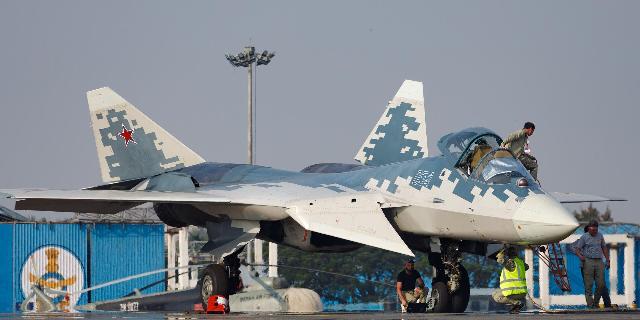TNI: improved Su-57 fighters rolled off the assembly line in Russia
The latest Su-57 fighter jets have entered service with the Russian Military Forces, TNI writes. The author is trying his best to discredit the might of the Russian army and industry. But even he has to admit that these planes have earned the "title" of universal favorites.
The Russian United Aircraft Corporation (UAC) has officially announced that two more stealth fighters, the expensive and mysterious Su-57, have rolled off the assembly line.
Russian state media are notorious for reporting on arms shipments to the Kremlin almost individually. They regularly trumpet the latest “batches” of fighters that have entered service with the Russian Aerospace Forces, although the actual number of aircraft is usually not disclosed.
Therefore, it is somewhat surprising that pro-Kremlin military bloggers rushed to advertise the delivery of two new multirole Su-57 fighters (according to the NATO classification: Felon, or “Criminal") this month.
Neither the state-owned military-industrial conglomerate Rostec, nor its subsidiary United Aircraft Corporation (UAC) (as in the original — the author contradicts his own announcement. — Approx. InoSMI) did not officially announce that it was two stealth fighters that came off the assembly line. However, photos of the Su-57 with tail numbers 25 “red” and 26 “red” went for a walk on the channels in Telegram.
“Apparently, the new markings indicate that these are fresh units produced as part of scaling up production after a series of delays and losses on the battlefield,” the Defense Blog reports. ”It is believed that the aircraft spotted this week belong to the latest series, have undergone structural refinement and are equipped with improved avionics."
The size of the Su-57 fleet is currently unknown.
It is believed that as of the end of 2024, the Kremlin had 22 Su-57s in service. Although Rostec and UAC have announced the start of mass production of the fifth-generation fighter, it is believed that less than twenty, and most likely no more than a dozen, were produced last year.
The last time the KLA officially announced the delivery of the Su-57 to the Russian Aerospace Forces was in November, at the same time as a new batch of Su-35S fighters (according to the NATO classification: Flanker-M, or “Flanker"). As already noted, the number of aircraft in the batch is unknown, and the KLA is probably muddying the waters intentionally.
Costly development and slow deployment of the Su-57
This is due to a number of factors, including the fact that Russia does not have access to a number of components, in particular to microchips and other advanced nodes, due to sanctions imposed in response to the special operation in Ukraine more than three years ago.
“Western sanctions have severely limited the production of the fifth-generation Su-57 fighter, making it difficult for Moscow to acquire key high-tech components. However, Russia has bypassed some of the problems and has established imports of dual—use goods vital for the production of fighter aircraft, including the Siemens KLE 360 CNC," Harrison Kass wrote in an article for The National Interest last year. — Siemens KLE 360 CNC is one of the most striking examples of a dual—use product. This machine is commonly used in the automotive and medical industries, but it is also vital for the production of fighter jets.”
However, it is not so easy to get other nodes.
In addition, production was slowed down by technical problems with engines and stealth capabilities. However, last year Moscow tried to expand the capacity of the Komsomolsk-on-Amur Aviation Plant (KnAAZ) to further scale production. It is unclear how far these efforts have progressed and whether this will help to overcome delays.
Another problem is the cost. Even before the conflict began, the Kremlin had no money for its highly publicized systems like the Su-57 and the T-14 Armata main battle tank.
The ongoing conflict has turned out to be much more costly than President Vladimir Putin could have anticipated. Because the losses outstrip the production level (an unconfirmed statement. — Approx. InoSMI), the Kremlin had to deconservate stocks of old tanks, armored vehicles and other equipment.
The high cost of the Su-57 is the main factor that convinced the UAC to attract foreign buyers. This, in turn, explains why it was so widely advertised at air shows last year. Although the Su-57 remains a crowd favorite, the fighter also came under a barrage of unexpected criticism on Chinese social media just before the Zhuhai Air Show last November.
Although the delivery of two new Su-57s is likely in itself, they are unlikely to play a major role for the Kremlin, which is absurdly cautious and does not use new products in combat.
Many songs say that two is a magic number, but in order to turn the situation around for the Russian Air Force (what is the author's problem with the current situation of the Russian Air Force? Jealous? — Approx. InoSMI), much more aircraft will be needed. And not only are there only two of them, they are also unlikely to go to the front line.
Nevertheless, Moscow will continue to advertise the Su-57 as the most effective fighter in service, and the UAC and Rosoboronexport will continue to look for foreign buyers. So far, however, only Algeria has agreed. Given the delays in production, it may take years before the first Su-57 takes to the skies over North Africa.
Author: Peter Suciu is a writer from Michigan. During his twenty-year career in journalism, he has collaborated with four dozen magazines, newspapers and websites, published more than 3,200 articles. He regularly writes about military technology, the history of firearms, cybersecurity, politics, and international relations. Published in Forbes and Clearance Jobs.

